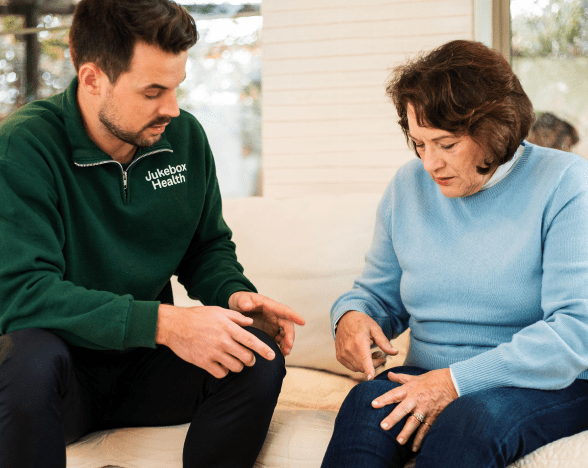Falls are a significant public health concern, often leading to severe injuries and a decline in overall quality of life for older adults. In the pursuit of preventive healthcare, identifying and addressing signs that indicate an increased risk of falling has become crucial.
However not all signs are immediately recognizable.
In this article we’ll explore three hidden signs that health plans need to be aware of as they pursue more proactive ways of engaging their members before a fall or incident occurs.
Fear of Falling

Although 36 million older adults will report a fall each year this doesn’t account for the millions of those that are experiencing a fear of falling in their home. An often overlooked indicator, fear of falling is actually one of the biggest indicators of fall risk (those that report a fear or 50% more likely to fall).
But why exactly is fear correlated with falling?
Although It's a layered issue, the psychological impact of a previous fall or even the mere anticipation of a fall can lead to a vicious cycle of decreased physical activity, muscle weakening, and loss of balance. Fear can even lead to increased heart rate, dizziness and general unsteadiness of the body - all of which can lead to changes in one’s mobility.
And for some older adults the fear of falling can become so great that they make changes to the amount of movement throughout the home.
When it comes to fear of falling it’s important for health plans to also realize that the fear of falling isn’t just a predictor of falls, it’s a predictor of limitations. This can include limiting access to certain rooms, limiting shower usage or even converting the first floor living. And in extreme situations, the fear of falling can be so great that those who are still physically able to complete tasks around the home still cut themselves off from any movement. Unfortunately this causes the body to become more susceptible to a fall. Muscles weaken, joints become tighter and with little activity throughout the day balance only becomes worse. In fact studies show that those who report a fear of falling are also more likely to experience a decline in ADLs such as bathing or eating.
Lack of confidence and social isolation can also cause older adults to feel the need to seek out forms of care assistance such as full time caregivers, to support many ADLs and IADLs even if they are physically capable of doing so independently. If plans are not closely monitoring and tracking an indicator such as fear of falling it can cost the member and the plan time, energy and money. Between a finite pool of resources, potential for overmedicalization and preventable financial burden, plans have a vested interest in ensuring a member’s plan of care is accurate and appropriate. By monitoring fear of falling plans can get a better look into a member’s life at home and better understand the root cause for one’s changes in mobility.
Chronic Illness

Chronic illnesses, such as diabetes, heart disease, and osteoporosis, are not only health concerns in themselves but also hidden indicators of an increased fall risk.
Depending on the specific diagnosis, it’s not uncommon for those living with a chronic condition to experience a spectrum of physical changes to their body and mobility. Many of these physical changes include increased muscle weakness, impaired vision and shuffling gait - which are all factors that have been proven to increase fall risk.
And countless studies show the direct correlation between specific conditions and the likelihood of experiencing a fall. These include:
- Over 50% of those living with Parkinson’s Disease will fall within the next year.
- Those with arthritis are 2.5 times more likely to report two or more falls and suffer a fall-related injury
- Those with Alzheimer's or Dementia are 8x more likely to fall.
- Cancer survivors have a 25%-30% higher rate of falls than the general population.
These conditions can compromise an individual's physical strength, balance, and coordination, making them more susceptible to falls. Furthermore, chronic pain or fatigue associated with these illnesses can lead to a decline in overall activity levels, which in turn contributes to muscle weakness and imbalance.
Addressing fall risk and enhancing home safety for individuals with chronic conditions is a crucial responsibility for health plans. By understanding the impact of chronic illnesses on fall risk and recognizing the importance of creating highly-targeted benefits, health plans can promote preventive care, improve member satisfaction, and achieve cost savings.
Urinary Incontinence
The last hidden sign, and maybe the most surprising, of fall risk is urinary incontinence.

Urinary incontinence can contribute to falls and recurring falls especially for those that find themselves waking up in the middle of the night and hurrying to the bathroom. Unsteady mobility in the dark from the bedroom to the bathroom is a highly common incident for most that report an at home fall. In fact, 29% of those we conduct home evaluations for report specific concerns about safety in the bedroom.
Furthermore, continuous waking up at night to go to the bathroom can often be associated with poor or destructed sleep. Decreased sleep quality, while an issue that is often overlooked, has been shown to lead to difficulty concentrating and slowed responses both of which can lead to an increase risk of falling.
Urinary incontinence can also pose a fall risk if medications such as anticholinergics or alpha blockers are being used. These medications can cause postural hypotension, a common symptom which causes one’s blood pressure to drop when sitting or standing up.
Although it can be hard for health plans to get full insight into urinary incontinence and the result of poor sleep, or certain medications it’s crucial that plans try to implement processes that help them uncover these concerns before an incident happens. We recommend all care management departments to revisit the questions they’re asking members. Home safety and falls risk questions should be asked regularly and questions surrounding hidden sights of fall risk are crucial to proactive care.
Lastly, health plans need to be aware of less likely, but just as important, fall risks caused by urinary incontinence. Which can include:
- Incontinence episodes may lead to slips on wet floor surfaces.
- Episodes of urinary incontinence may be transitory and often related to acute illness, such as urinary tract infections that can cause incontinence, delirium, drowsiness and hypotension.
The Importance of Health Plans' Awareness
Health plans' awareness of hidden indicators of fall risk is crucial.
By identifying and addressing these hidden signs plans can take proactive steps to prevent falls before they occur. This approach demonstrates the plan’s commitment to improving the overall well-being of members. In addition, plans that are attuned to hidden indicators of fall risk can also achieve significant cost savings.
While it may seem that the factors would be hard to identify there are a variety of ways to fit questioning and data capture processes directly into what’s already in place. For example:
- Care Management teams can add questions around fear of falling, chronic conditions and other concerns during their annual Health Risk Assessments calls.
- During in-home visits such as conducting care gape closures, risk adjustment interventions or having primary care in the home plans have the opportunity to question members and gain insight into any specific indicators that may be present but difficult to identify over the phone.
- Education can also be a great conversation starter between plans and members. Email newsletters, webinars and call outreach can be a great resource to help educate members on the hidden signs of fall risk for themselves and loved ones.
Lastly it’s critical that plans integrate proactive services to reduce fall risk for their members. Though partners such as Jukebox Health plans can access the network and resources needed to build comprehensive home safety programs for their members. Plus through our home assessment technology it’s easier than ever to gather robust clinical data and member insights - including these top hidden fall risk indicators.
Fall-related injuries lead to substantial healthcare expenditures, including hospital stays, surgeries, and long-term care services. In fact for plans, the average cost of an ED visit due to a fall is $8,701 and hospitalization due to a fall is $52,866 (National Center for Health Statistics-CDC).
This is costly and preventable.
By identifying and addressing fall risk factors before they escalate, health plans can help avoid these expensive interventions. Preventing falls also reduces the strain on healthcare resources and facilities, allowing for more efficient allocation of resources to address other, unavoidable, medical needs. This approach aligns with the broader goal of reducing healthcare costs and optimizing resource utilization.
Conclusion
Health plans' awareness of hidden indicators of fall risk is a pivotal aspect of preventive healthcare. By recognizing signs such as fear of falling, chronic illness, urinary incontinence, health plans can improve health outcomes, achieve cost savings, and enhance the overall quality of life for their members.
And collaborating with specialized services, like Jukebox Health, empowers health plans to ensure that these signs do not go unnoticed and that proactive measures are taken to prevent falls. If you’d like to learn more about how Jukebox Health can help your plan pin-point and report on these indicators please reach out directly to our team at hello@jukeboxhealth.com or (212) 321-5113.








